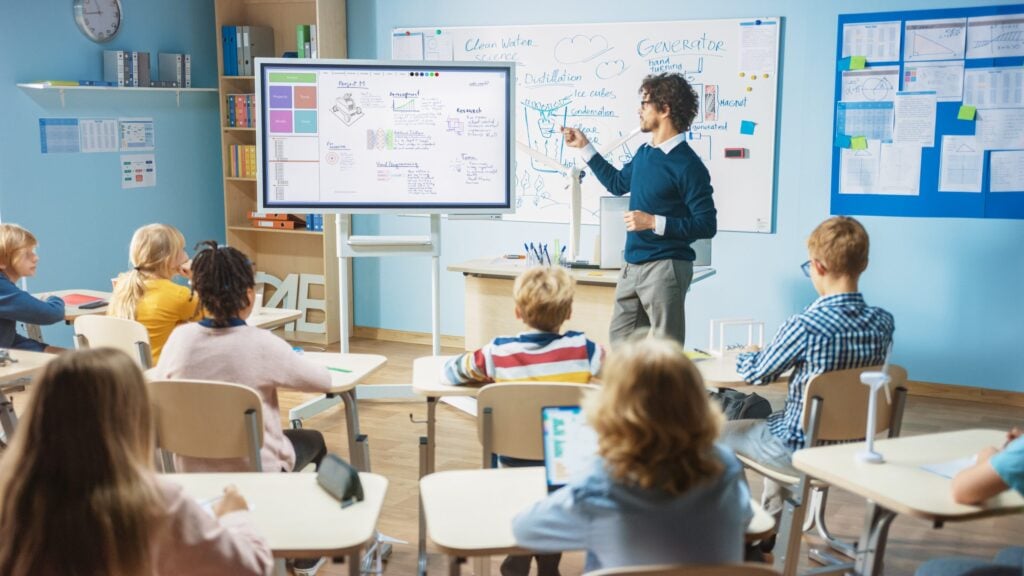Modern teachers face tons of challenges when adapting to new classroom realities and modern classroom technologies. These challenges can include lack of time to learn how to use technology, lack of understanding on how best to fit technology within their teaching style, online teaching with potentially unreliable devices, and much more.
Learn more about the benefits and challenges of technology in modern classrooms, along with 4 innovative solutions to help educators smoothly navigate new classroom realities.
Benefits and challenges of technology in modern classrooms
Better engagement
Technology in modern classrooms can include smart panels and projectors, devices that can wirelessly connect to panels and projectors and display work or data, and interactive software that requires students to engage with content directly. Immersing students in technology this way can, in turn, immerse them more fully in the information being taught.
Students, especially younger kids, tend to be more engaged when there’s a lot going on. Giving them meaningful, quality choices where they can focus their attention can help them stay engaged and absorbed in the lesson. However, keeping students engaged is always a challenge, and even helpful technology can sometimes become a distraction.
More individualized learning
No two students are alike, either in their grasp of the material or preferred learning styles. Modern classroom technology allows teachers to curate lessons and push out different content to different kids.
Consider a group of students divided into three learning levels. Group A can engage with the lesson plan as is. Group B requires a version with simpler explanations. Group C needs to be challenged slightly more. Teachers can leverage the different interactive programs available through their interactive products to individualize their students’ learning experiences.
Of course, customizing every lesson to accommodate different students’ learning needs can be a lot of extra work for already-overworked teachers. However, modern classroom technology usually comes with plenty of resources that can help make teachers’ lives easier.
Access to teacher resources
Busy teachers leveraging interactive screens, smart panels and projects, and other forms of technology in modern classrooms can often access resources provided by manufacturers. For example, educators can collaborate and ask questions in online classrooms or browse libraries of pre-canned lessons organized by grade, education standard, and more.
Integrating technology into the classroom
One of the biggest challenges that teachers face is actually integrating the technology they’re given into the way they are accustomed to teaching. If a school has the budget to update their classroom technology, they may consult with teachers about what they want, but it’s rarer for a discussion to occur about how the technology will be used.
Having to learn how to integrate new technology into the classroom can also come with a lot of pressure. Firstly, a teacher may be handed some technology and expected to adapt on-demand. In addition, if an administrator sees that technology is not being used, or is used incorrectly, the teacher may face a hand-slap or some other form of discipline.
4 innovative solutions for teachers facing modern classroom challenges
Utilize professional development days
When a teacher first receives new technology to leverage in the classroom, it can be overwhelming and create more work. However, professional development days are a mainstay for schools that offer a great opportunity for learning more about classroom technology.
Administrators can plan PD days for their entire staff to demonstrate educational software that comes with interactive flat panels. Teachers can also use their professional development time to get more familiar with the technology in their specific classroom settings.
Leverage resource libraries provided by manufacturers
Many interactive software solutions come with massive libraries containing lessons segmented by grade and education standard. Using these resources, teachers can drill down and find lessons that match what they’re planning to teach.
Even if educators don’t use these lessons and resources exactly as is, they still provide a starting point as they develop lessons. Leaning on manufacturers and their resources can help save valuable time.
Save and share content among peers
Having everything saved digitally can save more and more time the longer an education software is used. Teachers will not have to rewrite math problems from scratch, can resurface resources from many years before, and even share content among peers. Modern classroom technology can help keep information saved and organized for easy reference and sharing.
Lean on AV vendors to answer questions and solve problems
Here at Pro AV, one of our priorities is ensuring our clients get the most value out of their technological solutions. Instead of handing over a new piece or set of technology without any guidance regarding its potential impact and usefulness, our team will try to integrate things slowly.
For example, ramping up slowly and steadily allows teachers to become familiar with the basics before getting more granular with the use of software in the classroom. Soon enough, educators can feel comfortable with personalizing lessons, leveraging resource libraries, using the different software available, and more.
Learning how to use education technology and incorporate it seamlessly into the classroom can be difficult. However, teachers can leverage creative innovations to ensure their new classroom realities operate smoothly.
Our goal at Pro AV Systems is to facilitate this by providing technological solutions that add value for educators and guiding them to be able to use these solutions comfortably. Contact us to learn more about installing these solutions for your classrooms today.




